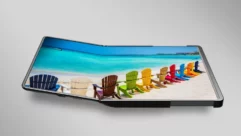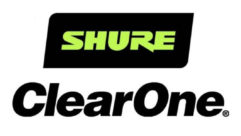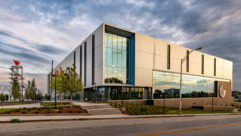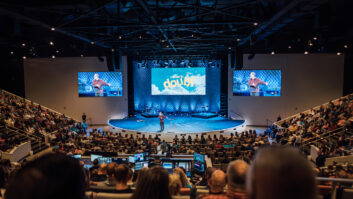Order In The Court
Technology can often be intimidating for inexperienced users, especially in a high-stress courtroom environment. But when properly designed and installed, AV technology can also make a courtroom more effective, as Atlanta-based law firm Alston & Bird discovered.
Courtroom aesthetics set the tone
CHALLENGE: Create an environment designed to simulate a real courtroom experience capable of capturing every aspect of legal proceedings, enabling attorneys and witnesses to review their actions, study jury responses and deliberations, and better prepare themselves for court.
SOLUTION: Install an automated system encompassing cameras, video displays, and audio equipment that can record all courtroom activities for later recall.
TECHNOLOGY CAN often be intimidating for inexperienced users, especially in a high-stress courtroom environment. But when properly designed and installed, AV technology can also make a courtroom more effective, as Atlanta-based law firm Alston & Bird discovered. With several regional offices throughout the country, Alston & Bird is a major U.S. law firm with an extensive national and international practice and 700 attorneys. The firm provides litigation, tax, intellectual property, technology, and transactional services.
To enhance support for its staff and clients, the firm’s partners sought a facility that would allow the courtroom environment to be re-created — including the ability to record actual courtroom proceedings — to help prepare attorneys and their witnesses. The firms’ partners and AV staff spent nearly two years visiting courtrooms across the country to compile a wish list of technology and features. During their visits, it became clear that while AV technology could be extremely beneficial, it could also be both intimidating and counterproductive if its implementation didn’t properly account for the stressful nature of a court of law.
While the AV technology in the Alston & Bird mock courtroom is central to the activity that takes place there, the firm didn’t want the technology to distract from the facility’s purpose as a court of law. “The main concern was that the courtroom remained a courtroom, with the technology being as visually transparent as possible so as not to distract from the proceedings,” says Chris Harkins, multimedia supervisor for Alston & Bird.
The firm decided that the high-tech facility needed to maintain a courtroom appearance free of technological distractions, and the system itself had to be easy to operate. Armed with a well-defined vision, Alston & Bird turned to Atlanta-based architectural design firm Carson Guest and Norcross, GA-based Technical Innovations for the AV design-build aspects of the project. Technical design planning was initiated in February 2003, and the project was completed in September 2004 after four months of construction at a cost of $500,000.
At first glance, Alston & Bird’s mock courtroom is a facility consisting of a judge’s bench large enough to accommodate three judges, a witness stand, a podium, tables for the prosecution and defense, and a jury box. Throughout the room, an anegre wood with a polished lacquer finish offers striking visual appeal. With the exception of four Panasonic AW-E600 cameras (ceiling mounted in the corners of the room) and a 42-inch NEC PX-42VP4A plasma display wall-mounted behind the jurors’ area, nothing appears unusual about the facility.
The courtroom is controlled via Crestron’s eControl2: C2ENET with Pro2 and AV2 processors. Jim Lanier, AV design engineer for Technical Innovations, designed and integrated the system, programming it to address the multiple audio and video feeds necessary to record all of the activity in the courtroom as well as the integration of the MSInteractive Perception Analyzer (see sidebar).
Lanier says the most pressing challenge with this project was determining all of the possible information sources, and programming the control system to readily accommodate each option. “What’s so important in order to make this type of project successful is to capture all of the information you can simultaneously,” Lanier says. “In this case, we’re talking about multiple sources of audio, video, and data collection from the jurors. By collecting this information, the client is then able to go back and review arguments from multiple perspectives — because you don’t always know what you’re looking for until after it actually happens.”
With the exception of the adjacent control room, the judge’s bench is the most comprehensive station in the system because he or she determines what materials the court can examine. This station is equipped with two Crestron TPS-6000 touchpanel controllers. These panels are programmed with a button that simultaneously activates sound masking (using a ClearOne XAP 800’s noise generator) over the jury box, mutes all microphones in the courtroom, and switches all controllers and displays to a default screen. Primarily used when the judge asks counsel to address the bench, the sound masking function prevents the jury from overhearing private conversations between the attorneys and the judge.
Order In The Court
Technology can often be intimidating for inexperienced users, especially in a high-stress courtroom environment. But when properly designed and installed, AV technology can also make a courtroom more effective, as Atlanta-based law firm Alston & Bird discovered.
The AV elementsThe control room/editing suiteDesigned for future expansionMSINTERACTIVE PERCEPTION ANALYZER
This judge’s bench also includes direct communication with the control room for additional support during proceedings. While the judge has final say over every aspect of the courtroom’s activity, Harkins can also offer support from the control room, if necessary. “The judge can select a signal source for display as well as block any signal he deems inappropriate — he sees everything introduced into evidence prior to anyone else seeing the materials,” Lanier says. “By having a direct tie-in to the control room, Harkins can provide additional AV support while remaining out of sight. The control room has the greatest level of signal routing capability. By working together, this approach ensures the highest degree of system flexibility while the technology remains transparent to those in the courtroom.”
The podium features a WolfVision Visualizer VZ-8 document camera and a Crestron TPS-3000 touchpanel, which enables the attorneys to control the display of testimony or evidence. Designed with very limited control capabilities to simplify its operation, this touchpanel enables counsel to select a laptop computer at the podium, as well as laptops at either the defense or prosecution tables as alternate sources.
The witness stand is also equipped with a Samsung 173T 17-inch LCD monitor and a Boeckeler Pointmaker tablet for annotating over video or graphics.
Video matrix switchers are central to the courtroom’s AV capabilities. To facilitate the complex signal routing between the control room, the bench, witness stand, podium, jury box, and jury deliberation rooms, the facility features two interconnected switchers: an Extron CrossPoint 1616 (16×16) matrix switcher, which handles RGBHV signals and two-channel stereo audio, and an Extron MAV 2424 AV (24×24) composite video and stereo audio matrix switcher.
The ceiling mounted Panasonic AW-E600 cameras are focused to provide a view of the bench, the podium, the jury box, and a wide shot of the courtroom. Housed in the adjacent control room, Crestron CPC-2000A and CPC-CAMI controllers provide live remote control of the cameras. This functionality enables Harkins to capture an attorney making a statement, followed by a shot of the jury’s reaction.
“The ability to capture multiple camera angles and audio sources simultaneously enables one to review every aspect of counsel’s argument — from the appearance of the attorney to the reaction of the jurors,” Lanier says. “Because what one says and how one presents that information may not always be in ‘sync,’ this multiple-source approach is really the only way to fully review an issue. This capability is critical in terms of being fully prepared.”
Toward the wall opposite the jury box, two Da-Lite 50- by 67-inch Electrol motorized screens are recessed into the ceiling areas — one each for the front and rear areas of the room. Hidden in the soffit over the jury box, NEC MultiSync GT2150 LCD projectors outfitted with NEC GT34ZL camera lenses provide images for the screens. A third Da-Lite Electrol screen positioned directly in front of the judge’s bench can also be deployed when the room is used as a presentation space.
An NEC PX42VP4A plasma display installed over the jury box allows counsel to see images the court is viewing (such as exhibits, presentations, or evidence) while addressing the jury — without having to turn their backs to the jurors. Because jury feedback is a critical aspect of the mock courtroom, multiple Samsung 173T 17-inch LCD monitors (which neither the judge nor counsel can see) were positioned in front of the jurors. From the adjacent control room, Harkins can send the jurors instructions, asking them to evaluate certain criteria using the MSInteractive Perception Analyzer — a data collection system that’s key to the operation of this facility.
For audio, Technical Innovations installed three ClearOne XAP 800 eight-input microphone mixers and a ClearOne XAP 400 four-channel microphone mixer with an integrated telephone hybrid and amplifier to provide remote audio during teleconferencing. The integrator also installed 21 wired microphones throughout the facility, including 15 Shure MX 418 gooseneck microphones for the bench, witness stand, podium, and prosecution and defense tables, in addition to six Crown PZM-10 boundary mics installed in the ceiling areas as well as in the two jury deliberation rooms. Thirty-two Klipsch IC-5T ceiling speakers powered by four Crown CTS 1200 power amplifiers provide sound reinforcement in the room.
The adjacent control room, which features a one-way mirror that enables Harkins to watch the proceedings without being detected by courtroom participants, houses Alston & Bird’s recording and editing equipment, and provides the most comprehensive access in terms of signal routing and control. For audio recording, Technical Innovations installed a Mackie SR24*4 VLZ Pro 24-channel mixer mated with a Tascam MX2424 24-channel hard disc recorder.
Four Sony DSRDR1000 DVCAM disc recorders are used to capture video feeds throughout the proceedings. The recorders are fed directly via SDI from the Panasonic AW-E600 ceiling cameras, providing Harkins with the necessary camera angles for assembling the courtroom video summaries. A Panasonic AG-MX70 eight-input digital AV mixer provides editing capabilities, while a Polycom VS4000 codec utilizing the company’s PRI (Primary Rate Interface) ISDN interface handles the courtroom’s videoconferencing tasks.
The control room also houses a Shure MX 418 microphone to facilitate communication with the judge, as well as a Crestron TPS-4500V touchpanel. This station provides the greatest control over the entire system, enabling Harkins to send any source to any destination. To keep track of courtroom activity as well as various video feeds, the equipment rack includes four JVC TM-A101GU 10-inch color production monitors, in addition to General Technics CS625 rackmount LCD monitors at the desk.
FOR MORE INFORMATION
Boeckelerwww.boeckeler.com
ClearOnewww.clearone.com
Crestronwww.crestron.com
Crownwww.crownaudio.com
Da-Litewww.da-lite.com
Extronwww.extron.com
General Technicswww.gtweb.net
JVCwww.jvc.com
Klipschwww.klipsch.com
Mackiewww.mackie.com
MSInteractivewww.perceptionanalyzer.com
Panasonicwww.panasonic.com
Polycomwww.polycom.com
Samsungwww.samsung.com
Shurewww.shure.com
Sonywww.sony.com
Tascamwww.tascam.com
WolfVisionwww.wolfvision.com
As technology continues to improve, Alston & Bird can rest assured its new courtroom is ready to accommodate future upgrades. The Extron matrix switching systems address a key element in this plan. “We installed a large matrix switching system specifically with expansion in mind — so whatever comes our way, we’ll have space for it,” says Tom Norris, director of field operations at Technical Innovations. “The ability to handle all of the various recording configurations within the room required some very sophisticated programming. The ease of operation this system presents to an executive-level user makes quite a statement. The client is so happy, we’re now looking at duplicating the environment at other locations.”
Central to Alston & Bird’s mock courtroom is its ability to collect data from the jury, which enables attorneys, witnesses, and others to be fully prepared when they arrive in court. An 18-unit MSInteractive Perception Analyzer system enables the firm to collect information from jurors in a completely anonymous manner —free from the influence of group leaders or other factors.
The Perception Analyzer (PA) is an interactive feedback device that enables researchers, instructors, and other users to obtain instant, unbiased information from a group with the use of a wireless, handheld unit featuring a rotary dial and an LED display. For example, an administrator in the control room can send a message to the LCD monitors in the jury box, instructing jurors to gauge the perceived sincerity of counsel’s argument —with a value of 50 representing the median. Jurors could be instructed to enter a numeric value with higher numbers representing “agree” or “strongly agree,” while lower values might represent the opposite. Once tabulated, the firm can determine why one particular argument succeeds while another falls flat. Responses can be tabulated quickly and data can be exported for post-group analysis.
The MSInteractive Perception Analyzer includes four software packages: a Hardware Setup module, PA Edit for composing questions and research strategies, PA Collect for data collection, and PA Report for compiling, viewing, and reporting data. Using a Panasonic AG-MX70 digital AV mixer, Alston & Bird’s collected data can be inserted via video overlay or incorporated into presentation software.
Roger Maycock is the owner of MountainCrest Communications in Downey, CA. A recognized music and sound authority, Maycock has written hundreds of technical articles for a number of trade and consumer publications. He can be reached at [email protected].










